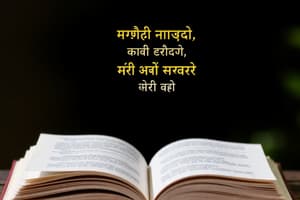Podcast
Questions and Answers
What is the alphabet used in Hindi known as?
What is the alphabet used in Hindi known as?
- Abugida script (correct)
- Abjad
- Cuneiform
- Alphasyllabary
Which structure does Hindi grammar primarily follow?
Which structure does Hindi grammar primarily follow?
- Subject-Object-Verb (SOV)
- Object-Verb-Subject (OVS)
- Verb-Subject-Object (VSO)
- Subject-Verb-Object (SVO) (correct)
What does Hindi use extensively instead of prepositions?
What does Hindi use extensively instead of prepositions?
- Postpositions (correct)
- Interjections
- Conjunctions
- Preverbs
How many sets of verbs does Hindi have for tense formation?
How many sets of verbs does Hindi have for tense formation?
What system does Hindi employ to indicate respect and social status between speakers?
What system does Hindi employ to indicate respect and social status between speakers?
How would you describe the history of Hindi literature?
How would you describe the history of Hindi literature?
Which literary figure from Hindi literature is known as a modern poet?
Which literary figure from Hindi literature is known as a modern poet?
In the 12th-grade Hindi curriculum, what aspect of literary texts is students encouraged to critique?
In the 12th-grade Hindi curriculum, what aspect of literary texts is students encouraged to critique?
What is emphasized as an important skill in the 12th-grade Hindi curriculum?
What is emphasized as an important skill in the 12th-grade Hindi curriculum?
Which genre emerged in the 20th century within Hindi literature?
Which genre emerged in the 20th century within Hindi literature?
What aspect of Hindi grammar is highlighted in the conclusion of the text?
What aspect of Hindi grammar is highlighted in the conclusion of the text?
What language influenced the Hindi literary tradition during the British colonial era?
What language influenced the Hindi literary tradition during the British colonial era?
Flashcards are hidden until you start studying
Study Notes
Hindi: A Comprehensive Overview
Hindi, a language predominantly spoken in the northern regions of the Indian subcontinent, is a rich and complex linguistic system that has evolved through centuries of history and cultural exchange. In this article, we'll explore its grammar, literature, and the Hindi curriculum in 12th-grade education.
Hindi Grammar
Hindi is an Indo-Aryan language with its grammar based on the Sanskrit language. Its alphabet, known as Devanagari, is an abugida script, meaning it combines the characteristics of an abjad (a system of writing in which letters denote consonants) and an abjad-syllabary (a system of writing in which letters denote syllables).
Hindi grammar is relatively straightforward compared to other languages. Like most Indo-Aryan languages, it employs a subject-verb-object (SVO) structure. Its nouns are marked for gender, number, and case. The language makes extensive use of postpositions instead of prepositions, and it has a unique system of honorifics that indicates respect and social status between speakers.
Hindi also uses a rich and intricate system of verb conjugations, allowing for the formation of tenses and moods. For instance, Hindi has two sets of verbs: one for past tense and one for the present tense and future tense. This system is similar to Latin, but Hindi has no separate verb form for the future tense in the present tense.
Hindi Literature
Hindi literature has a rich and diverse history spanning over thousands of years. This literary tradition includes works of poetry, prose, and drama, written in the Sanskrit and Braj Bhasha languages before the emergence of Hindi as a standardized language.
Prominent figures in Hindi literature include the medieval poet Kabir, the 19th-century poet and philosopher Ramdhari Singh Dinkar, and the modern poet Nirala. Contemporary authors such as Amrita Pritam, Shivani, and Mahasweta Devi have also contributed to the development of Hindi literature.
The Hindi literary tradition has been influenced by various cultural and linguistic movements, including the Sanskrit tradition, Persian literature, and the British colonial era. The 20th century saw the birth of several modern genres such as short stories, novels, and plays.
12th-grade Hindi Curriculum
Hindi is a mandatory subject in the Indian 12th-grade curriculum, where it is studied at the intermediate level. The curriculum covers a wide range of topics, including grammar, literature, and vocabulary. Students are required to study a variety of literary texts and writings, from classical works to contemporary literature.
The syllabus for 12th-grade Hindi also includes the study of the literary devices, figures of speech, and literary analysis techniques. Students are encouraged to develop their writing and analytical skills by composing original essays, critiquing literary texts, and engaging in discussions about literary works.
Moreover, the curriculum emphasizes the importance of understanding the cultural context of literary texts, including their historical, social, and philosophical backgrounds. Students are also encouraged to develop their spoken and listening comprehension skills through debates, discussions, and presentations.
Conclusion
Hindi is a vibrant and sophisticated language with a rich literary tradition that spans thousands of years. Its grammar is relatively straightforward compared to other languages, but it still has a unique system of verb conjugations and honorifics. Its curriculum at the 12th-grade level encourages students to develop their writing, analytical, and communication skills.
Whether you're learning Hindi as a second language or studying its literature, there's no denying the richness and complexity of this fascinating language and its literary tradition. So, put on your learning cap and dive into the world of Hindi, where the possibilities for exploration and discovery are endless.
Studying That Suits You
Use AI to generate personalized quizzes and flashcards to suit your learning preferences.




